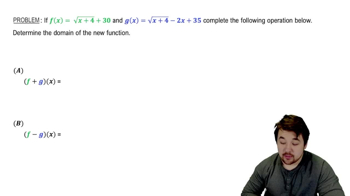A function value Show that the function F(x) = ( x − a)²(x − b)² + x takes on the value (a + b)² for some value of x.
Table of contents
- 0. Functions7h 54m
- Introduction to Functions16m
- Piecewise Functions10m
- Properties of Functions9m
- Common Functions1h 8m
- Transformations5m
- Combining Functions27m
- Exponent rules32m
- Exponential Functions28m
- Logarithmic Functions24m
- Properties of Logarithms36m
- Exponential & Logarithmic Equations35m
- Introduction to Trigonometric Functions38m
- Graphs of Trigonometric Functions44m
- Trigonometric Identities47m
- Inverse Trigonometric Functions48m
- 1. Limits and Continuity2h 2m
- 2. Intro to Derivatives1h 33m
- 3. Techniques of Differentiation3h 18m
- 4. Applications of Derivatives2h 38m
- 5. Graphical Applications of Derivatives6h 2m
- 6. Derivatives of Inverse, Exponential, & Logarithmic Functions2h 37m
- 7. Antiderivatives & Indefinite Integrals1h 26m
- 8. Definite Integrals4h 44m
- 9. Graphical Applications of Integrals2h 27m
- 10. Physics Applications of Integrals 3h 16m
- 11. Integrals of Inverse, Exponential, & Logarithmic Functions2h 31m
- 12. Techniques of Integration7h 41m
- 13. Intro to Differential Equations2h 55m
- 14. Sequences & Series5h 36m
- 15. Power Series2h 19m
- 16. Parametric Equations & Polar Coordinates7h 58m
1. Limits and Continuity
Continuity
Problem 2.5.66
Textbook Question
The sign-preserving property of continuous functions Let f be defined on an interval (a, b) and suppose that f(c) ≠ 0 at some c where f is continuous. Show that there is an interval (c − δ, c + δ) about c where f has the same sign as f(c).
 Verified step by step guidance
Verified step by step guidance1
Consider the definition of continuity: A function f is continuous at a point c if for every ε > 0, there exists a δ > 0 such that for all x in the interval (c - δ, c + δ), |f(x) - f(c)| < ε.
Since f(c) ≠ 0, we can choose ε = |f(c)|/2. This choice of ε ensures that f(x) is not zero in the interval (c - δ, c + δ).
By the continuity of f at c, there exists a δ > 0 such that for all x in (c - δ, c + δ), |f(x) - f(c)| < |f(c)|/2.
This inequality implies that f(x) is closer to f(c) than it is to zero, meaning f(x) and f(c) have the same sign. Specifically, if f(c) > 0, then f(x) > 0, and if f(c) < 0, then f(x) < 0.
Thus, there exists an interval (c - δ, c + δ) where f(x) maintains the same sign as f(c), demonstrating the sign-preserving property of continuous functions.
 Verified video answer for a similar problem:
Verified video answer for a similar problem:This video solution was recommended by our tutors as helpful for the problem above
Video duration:
3mPlay a video:
Was this helpful?
Key Concepts
Here are the essential concepts you must grasp in order to answer the question correctly.
Continuous Functions
A function is continuous at a point if the limit of the function as it approaches that point equals the function's value at that point. This means there are no breaks, jumps, or holes in the function at that point. For continuous functions, small changes in the input result in small changes in the output, which is crucial for understanding the behavior of the function around a specific point.
Recommended video:

Intro to Continuity
Sign of a Function
The sign of a function at a point refers to whether the function's value is positive, negative, or zero. In this context, if f(c) is positive, we expect f to remain positive in a neighborhood around c, and similarly for negative values. Understanding the sign of a function helps in analyzing its behavior and determining intervals where the function maintains a consistent sign.
Recommended video:

Adding & Subtracting Functions Example 1
Delta-Epsilon Definition of Continuity
The delta-epsilon definition formalizes the concept of continuity by stating that for every ε > 0, there exists a δ > 0 such that if |x - c| < δ, then |f(x) - f(c)| < ε. This means that we can make the function values as close to f(c) as desired by choosing x sufficiently close to c. This concept is essential for proving that a function retains its sign in a neighborhood around a point where it is continuous.
Recommended video:

Definition of the Definite Integral
Related Videos
Related Practice
Textbook Question


